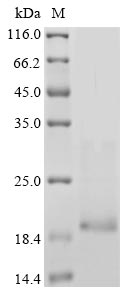Recombinant Human Neurotrophin-3 (NTF3) is expressed in a baculovirus system, spanning amino acids 139-257, which represents the full length of the mature protein. This product features dual tagging with an N-terminal 10xHis tag and a C-terminal Myc tag, making purification and detection more straightforward. The protein is purified to greater than 85% as determined by SDS-PAGE, ensuring a high-quality reagent suitable for research applications.
Neurotrophin-3 (NTF3) belongs to the neurotrophin family, which appears crucial for nervous system development and function. It likely plays a significant role in neuronal survival, development, and differentiation. NTF3 seems involved in key signaling pathways and represents a vital component in studies related to neural plasticity and neurodegenerative diseases.
Potential Applications
Note: The applications listed below are based on what we know about this protein's biological functions, published research, and experience from experts in the field. However, we haven't fully tested all of these applications ourselves yet. We'd recommend running some preliminary tests first to make sure they work for your specific research goals.
The Baculovirus Expression Vector System (BEVS) is generally advantageous for expressing eukaryotic proteins because insect cells can perform many necessary post-translational modifications and provide a folding environment closer to mammalian cells than prokaryotic systems like E. coli. This increases the probability of obtaining a correctly folded protein. Nonetheless, this is not a guarantee. The presence of two tags, particularly the large N-terminal 10xHis tag, introduces a significant risk of steric interference that could disrupt the protein's native folding, its ability to form the required stable dimeric structure, or its interaction with the high-affinity TrkC receptor. Research has shown that even a single His-tag, depending on its location (N- vs. C-terminus), can alter enzyme kinetics, protein stability, and biological activity. While the baculovirus system is favorable, the correct folding and bioactivity of this specific dual-tagged recombinant NTF3 protein must be experimentally verified.
1. In Vitro Neuronal Cell Culture Studies
This recombinant NTF3 could be used to study neurotrophin signaling only if its folding and bioactivity are first confirmed. The baculovirus system may support native-like modifications, but the dual tags, especially the large N-terminal His-tag, could sterically hinder binding to the TrkC receptor or alter dimerization, critical for signaling. Without validation via a functional neuronal survival or neurite outgrowth assay, dose-response studies may yield inaccurate EC₅₀ values or false negatives.
2. Protein-Protein Interaction Studies
The tags facilitate technical procedures like immobilization (His-tag) and detection (Myc-tag). However, if the tags interfere with native folding, they could mask or distort key interaction interfaces. This might lead to the identification of non-physiological binding partners or failure to detect true interactions with receptors like TrkC or p75ᴺᵀᴿ. Any interactions identified require confirmation with untagged, native NTF3.
3. Antibody Development and Validation
The full-length, high-purity protein is suitable as an immunogen for generating antibodies, particularly those targeting linear epitopes. However, if the protein is misfolded, antibodies generated may not effectively recognize the native, biologically active NTF3 in physiological settings (e.g., in immunofluorescence or neutralization assays), as they might miss conformational epitopes. The tags themselves could also induce antibody responses that are not specific to the NTF3 sequence.
4. Biochemical Characterization and Structural Studies
The protein's suitability for meaningful structural or biophysical analysis is highly dependent on correct folding and homogeneity. Techniques like circular dichroism or dynamic light scattering can be applied, but the data will reflect the state of the tagged protein. The tags, particularly the flexible N-terminal His-tag, could influence results by affecting oligomerization state or spectral properties, potentially leading to misinterpretations of the native protein's characteristics.
5. Receptor Binding Assays
This application is critically dependent on correct folding. The primary biological function of NTF3 is to bind its receptors TrkC and p75ᴺᵀᴿ with high affinity and specificity. If the tags, especially the N-terminal tag, disrupt the structure of the receptor-binding domains, the protein will show compromised or aberrant binding kinetics, rendering competitive binding or direct affinity measurements invalid. A functional binding assay using a validated positive control is a prerequisite.
Final Recommendation & Action Plan
To ensure reliable and interpretable results, it is strongly recommended to first experimentally validate the folding and bioactivity of this recombinant NTF3 protein before committing to functional applications. The action plan should begin with biophysical characterization using size-exclusion chromatography coupled with multi-angle light scattering (SEC-MALS) to assess the oligomeric state (it should be a dimer) and monodispersity, and circular dichroism (CD) spectroscopy to analyze secondary structure content against known spectra. This should be followed by a functional bioactivity assay, such as measuring the promotion of survival or neurite outgrowth in a TrkC-expressing neuronal cell line (e.g., PC12 cells engineered to express TrkC), to determine a specific activity (e.g., EC₅₀) and compare it to literature values. If the protein passes these validation steps, it can be used confidently for the proposed applications, with the understanding that tag-related effects might still be a confounding factor. If validation fails, its use should be restricted to applications less dependent on native conformation, such as generating linear-epitope antibodies, with all limitations clearly disclosed in any research communications .






